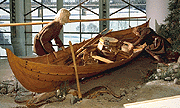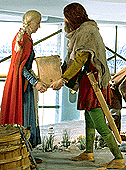Canada Hall
 The Norse
The Norse
What Europeans considered a "New World" was in fact home to Native
people for over 15,000 years before the first Europeans landed on the
eastern shores of North America. Around A.D. 1000, the medieval Norse (Vikings)
established the first European settlement, on the northern coast
of Newfoundland,
but they only stayed for a brief period.
Speculation about the
Norse expeditions to
North America was based primarily on traditional Icelandic sagas, which
are supported by direct evidence uncovered by archaeologists since
the 1960s. A handful of Norse artifacts scattered across the
islands of the High Arctic and the remains of a settlement at
L'Anse
aux Meadows, Newfoundland, suggest unequivocally that the
Norse were present in North America 500 years before
Christopher
Columbus arrived in l492.
The clothing,
jewellery, and tools used by the Norse indicate that they were not
peasants, but rather members of the prosperous yeoman farming class.
They were likely descendants of chieftains who were forced to seek
new land in the ninth century. At that time,
King Harald
Fairhair of Norway attempted to unify his realm through subjugation of
lesser kings, which forced many to flee to Britain, Iceland,
Greenland, and beyond. The pendants worn by the mannequins reflect the
changing times. They feature the hammer of the pagan god
Thor
and the cross of the newly adopted Christian religion.

 At the end of the ninth century, a gradual migration began across the
North Atlantic. Several hundred families left the Norwegian coast aboard
knorrs
-- rugged cargo vessels three times
larger than the coasters then plying the North Sea -- to settle in Iceland.
A century later, Eric
the Red led their descendants to Greenland
and a few of them followed his son, Leif
the Lucky, as far as North America. Since the Norse used
open ships offering no protection from the elements and lacked even
the most rudimentary navigational devices, they had to cross the North
Atlantic island by island, from Norway to North America. Each leg of
the journey was about 600 kilometres.
At the end of the ninth century, a gradual migration began across the
North Atlantic. Several hundred families left the Norwegian coast aboard
knorrs
-- rugged cargo vessels three times
larger than the coasters then plying the North Sea -- to settle in Iceland.
A century later, Eric
the Red led their descendants to Greenland
and a few of them followed his son, Leif
the Lucky, as far as North America. Since the Norse used
open ships offering no protection from the elements and lacked even
the most rudimentary navigational devices, they had to cross the North
Atlantic island by island, from Norway to North America. Each leg of
the journey was about 600 kilometres.
 The first exhibit in the Canada Hall depicts a Norse family
unloading tools and supplies from a small boat, known as a
faering, upon their arrival in Newfoundland. The ship
that brought the settlers from Greenland is anchored offshore. The
lightweight construction of the boats (overlapping planks placed
lengthwise and rivetted together) meant that they could be safely
navigated in shallow water even when loaded.
The first exhibit in the Canada Hall depicts a Norse family
unloading tools and supplies from a small boat, known as a
faering, upon their arrival in Newfoundland. The ship
that brought the settlers from Greenland is anchored offshore. The
lightweight construction of the boats (overlapping planks placed
lengthwise and rivetted together) meant that they could be safely
navigated in shallow water even when loaded.
 In the l960s, archaeological excavations at
L'Anse
aux Meadows uncovered the remains of eight
turf-walled structures -- three large dwellings,
two small workshops, a forge, a shed and a small sod construction.
Most of the artifacts found at the site were iron boat rivets and
floorboards from small watercraft, which suggests that boat construction
and repair was a principal activity. Other objects include a bronze-ringed
cloak pin similar to the one worn by the female mannequin on display, a
soapstone spindle whorl, and a stone lamp. The discovery of the spindle
whorl, used by women to spin wool, is evidence that families came
to the site. In other words, this was a genuine attempt at
settlement, not just an outpost for explorers. The absence
of a large garbage midden and the fact that the structures
do not appear to have been rebuilt indicates that the settlement was
abandoned after a relatively short period. Over the next two or
three centuries, the Norse probably continued to make periodic
crossings from their colonies in Greenland, in order to procure
timber from the coast of Labrador. They may also have traded
occasionally for furs and walrus ivory with the Native peoples of
the Canadian Arctic.
In the l960s, archaeological excavations at
L'Anse
aux Meadows uncovered the remains of eight
turf-walled structures -- three large dwellings,
two small workshops, a forge, a shed and a small sod construction.
Most of the artifacts found at the site were iron boat rivets and
floorboards from small watercraft, which suggests that boat construction
and repair was a principal activity. Other objects include a bronze-ringed
cloak pin similar to the one worn by the female mannequin on display, a
soapstone spindle whorl, and a stone lamp. The discovery of the spindle
whorl, used by women to spin wool, is evidence that families came
to the site. In other words, this was a genuine attempt at
settlement, not just an outpost for explorers. The absence
of a large garbage midden and the fact that the structures
do not appear to have been rebuilt indicates that the settlement was
abandoned after a relatively short period. Over the next two or
three centuries, the Norse probably continued to make periodic
crossings from their colonies in Greenland, in order to procure
timber from the coast of Labrador. They may also have traded
occasionally for furs and walrus ivory with the Native peoples of
the Canadian Arctic.

